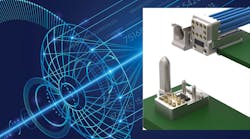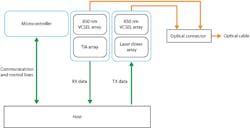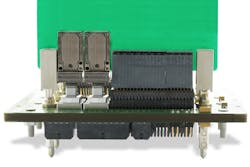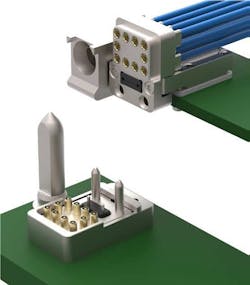Download this article in PDF format.
The emergence of IoT in cloud computing and the demand for 4G and 5G networks worldwide are driving increased usage of optical transceivers in a wide variety of applications: business, government, industrial, academic, and cloud servers in public and private networks. Both local-area networks (LANs) and wide-area networks (WANs) are demanding more bandwidth packed into smaller spaces, and traditional copper interconnects can’t satisfy the insatiable appetite of all the network servers and gateway devices.
Furthermore, the next generation of networking devices will need to be even more compact and faster. According to market research firm Radiant Insight, the optical transceiver market will reach $9.9 billion by 2020, three times its 2013 level.
Optical transceivers are the key components that transform electrical signals to light over optical cables. At the receiving end, another optical transceiver will convert the light back to electrical signals (Fig. 1). Most transceivers operate with speeds of 10, 40, and 100 Gb/s. When higher speed is needed, multiple lanes are used in parallel to deliver the required bandwidth.
1. This is a demonstration of conversion of digital data and fiber-optic light signals.
What Are the Advantages of Optical Networks?
Fiber-optic networks or embedded communication systems have three key components: the optical transmitter, the fiber-optical cable, and the optical receiver. As described above, the transmitter converts electrical signals to light using either light-emitting diodes (LEDs) or laser diodes. At the receiving end, a photodetector is used to convert the light back to electrical signals. A transceiver combines the transmitter and receiver in one module (Fig. 2).
2. The block diagram of LightABLE LM SR4 transceiver represents the typical functions of a transceiver.
The advantages of using fiber optics instead of copper include higher bandwidth, longer distance links, reduced weight, immunity to electromagnetic interference, and increased security.
Applications for embedded fiber optics are very broad and they often include projects that require very large bandwidth in confined areas, typically co-located with high-speed, high-port-count FPGAs or ASICs. Many of the civilian and military command and control monitoring systems (C4ISR), radar, FPGA interfaces, multiprocessor interconnects, CCD/CMOS imaging sensor arrays, high-fidelity radar imagery, and systems requiring secure communications use fiber optics.
Challenges in Designing Embedded Systems with Optical Interconnects
Three major challenges crop up when designing embedded optical interconnects:
- Creating an embedded system to support maximum bandwidth with the smallest possible footprint.
- Designing or selecting the best optical interconnect that can perform in harsh environments with maximum mean time between failure (MTBF).
- Future-proofing the embedded system to maximize the return on system investment.
Balancing performance, space, power, and cost is a constant tradeoff and challenge. The design will depend largely on the bandwidth requirements of the embedded system, which can be a single-board computer (SBC) or multiple boards that fit in a chassis. Some of these network systems need to support many gigabits per second; thus, the system design will also depend on the size and throughput of the interconnect.
Multiple components may be needed, which can increase the size of the SBC or chassis, and power and cooling requirements can also impact the overall system footprint. Many commercial-grade optical interconnects operate in a limited temperate range and aren’t able to handle the shock and vibration of harsh environments, and some systems may need to operate in humid conditions.
All of these environmental factors will directly or indirectly affect the operational performance and lifespan of the products. In other words, a high-performance system will typically consume more power and require better cooling, resulting in larger size and costing more. Therefore, tradeoff in system design is always an important consideration.
In Search of the Best Fiber-Optic Interconnect Solutions
Many considerations must be addressed when selecting the best fiber-optic interconnect solution, and they often require tradeoffs. The main considerations include investment protection, product performance, form factors, reliability, and integration considerations. The following provides guidelines in selecting or designing optimal embedded fiber optic interconnect solutions.
Standard-based solutions protect purchase investments
System performance is influenced by many factors, and there are a few rules of thumb to bear in mind:
- The smallest form factor is desirable.
- Always choose rugged and reliable solutions even if they cost more.
- Guidelines for module integration and configuration should be observed.
Though numerous proprietary designs are available, the best approach is to select VITA standard-based solutions because they’re supported by a consortium along with a large ecosystem. Therefore, the design will be supported with upgrades over time. In addition, the standard defines the technology and connector specifications, which enables developers and integrators to select from multiple VITA-based vendors.
Many factors have an impact on system performance
Fiber-optic technology is capable of providing high-speed, low-latency, long-distance communication with no electrical noise interference. However, multiple factors will impact the true, sustained performance and potential distance of the communication links. These factors include communication error rate, link budget, and receiver sensitivity.
Moreover, when doing system design, it’s important that full-duplex is part of the equation. Some new configurations can achieve up to 600-Gb/s bandwidth, but there’s overhead involved that may affect the actual throughput. For example, an unstable transceiver with high error rate will cause the system to perform retransmission, which will decrease the overall system performance. The measure of this phenomenon is referred to as bit error rate (BER).
3. The 600G LightCONEX plug-in module is composed of two 24-lane transceiver side by side.
For fiber-interconnect devices or systems, the minimum BER should be 10-12. Higher performance can be achieved if BER is 10-15 or better. BER of 10-12 means that one error occurs every trillion transmissions. In addition, a link budget greater than 13 dB with receiver sensitivity of −12 dBm are recommended (Fig. 3).
Smallest form factor is desirable
More and more embedded systems including SBCs are using a smaller form factor. Therefore, it’s important to select modules with the smallest footprint possible. Fiber-optic transceiver modules can be as small as 1.3 cm × 1.3 cm (Fig. 4). Also, consider low profiles modules with a height of less than 5 mm. This will allow room for the SBC or systems to add additional functions on board.
4. The 150G and 300G LightCONEX optical transceivers have a very small footprint.
Always choose rugged and reliable solutions even when they cost more
Many fiber-optic systems are used in harsh environments. As a result, commercial-grade products will often fail or, at the minimum, have a shortened service life. It’s important to choose solutions that will survive the environments of the target applications. Typical operating temperature should be from −40 to 100°C or better with storage temperature from −57 to 125°C. In addition, if the module consumes less power (100 mW per lane or better), it will create less heat and help achieve better MTBF.
Other considerations should include shock and vibration resistance, passing MIL-STD-883 or better. The module also should be sealed to prevent corrosion due to exposure to moisture. As a rule of thumb, it’s recommended that products pass the following tests to ensure the highest quality:
MIL-STD-883
- Vibration tests, Method 2007.3
- Mechanical shock tests, Method 2002.4
- Thermal shock tests, Method 1011.9
- Thermal cycling tests, Method 1010.8
MIL-STD-202
- Damp heat tests, Method 103B MIL-STD-810
- Cold storage tests, Method 502.5
Rules for module integration and configuration should be observed
A well-designed transceiver should take into account the connector choice and location, as well as ease of system integration and configuration. An active blind-mate optical design will make connector mating much easier and reduce the chances of making connection mistakes (Fig. 5).
5. This VPX blind-mate connector comprises a 24 fiber MT ferrule and 10 RF coaxial connectors. The size of this connector meets VITA 66.4 standard.
There are two other rules to follow when considering connector selection or design. First, follow the VITA 66.5 “Optical Interconnect on VPX, Spring Loaded Contact on Backplane” standard that defines the connector dimensions. Then place the board-edge, plug-in module connector near the edge of the board, integrating an active parallel optic transceiver, and a spring-loaded backplane connector developed for VPX systems (part of the VITA standard) (Fig. 6). This approach will limit any additional cabling needed to bring the signals to the edge of the SBC board.
6. LightCONEX Active Blind Mate VPX Optical Interconnect.
The Embedded Interconnects Design Checklist
The following can serve as a check list for ease-of-use:
1. Select solutions based on the VITA standard including VITA Section 6. This applies to the overall systems as well as the connectors.
2. For optimal system performance, select modules with low bit error rate (BER) such as 10-15.
3. Select small-form-factor modules in the range of 1.5 cm x 1.5 cm, with height profiles less than 5 mm. This will provide extra space for the circuit board.
4. Select rugged and reliable solutions that pass a minimum set of tests including the following:
MIL-STD-883:
- Vibration tests, Method 2007.3
- Mechanical shock tests, Method 2002.4
- Thermal shock tests, Method 1011.9
- Thermal cycling tests, Method 1010.8
MIL-STD-202:
- Damp heat tests, Method 103B
MIL-STD-810:
- Cold storage tests, Method 502.5
5. Select design/modules that are easy to integrate. These include blind-mate and broad-edge connectors.
Conclusions
This article has outlined the advantages and challenges of using fiber-optic interconnects. To use fiber-optic cables, the electrical signals need to be converted to light signals using fiber-optic transceivers. While there are many challenges to embedded fiber-optics design, the benefits are substantial. The guidelines and design checklist provided will help developers select the best solutions for their needs.
Gerald Persaud is V.P. Business Development, and David Rolston, Ph.D., is Chief Technology Officer at Reflex Photonics.







